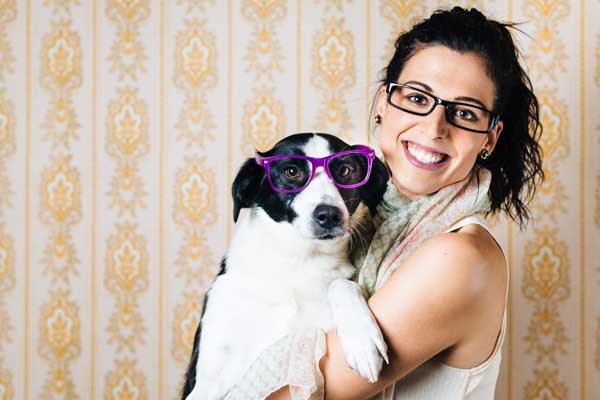If we humans had to name the sense that was most vital in helping us navigate the world, many would choose vision. Sure, hearing is highly advantageous; and some might argue that taste, touch and smell help make life worth living. But if you stop and consider, even our human language is oriented toward the visual: we “see” the point; have high “regard” for things we like; share different “views” on a subject. But dog vision is a much different use of this sense.
How Dogs Use Sight

How dogs see and use sight is very different from us humans. Woman and dog in glasses. Photography by Dirima / Shutterstock.
Few individuals would examine their brand-new smartphone by giving it a few experimental sniffs. Yet that’s exactly how our dogs acquaint themselves with new situations. For canines, noses and tongues easily trump eyes when it comes to sensory input.
That certainly doesn’t mean dog vision is useless — but “contributory” might be a reasonable term. In fact, most vets would agree that blind and low-vision canines can learn to get along perfectly well by letting their snouts and taste buds lead the way.
“Blind canines generally adapt quickly to their environments, especially if furniture placement and routines are kept consistent,” notes Dr. Lisa McIntyre, owner and founder of The Welcome Waggin’ mobile veterinary service. “They rely on senses such as hearing and smell much more than they rely on their vision to assess and navigate their surroundings.”
Placed side-by-side, diagrams of the canine and human eye might initially seem comparable. The basic apparatus is, in fact, fairly similar. Eyelids protect the cornea, which is a transparent covering for the iris and pupil. The iris narrows or widens to allow light into the eyeball’s interior structure. This light travels through a lens, which focuses the light as it hits the retina toward the back of the eye. The retina converts the light and sends the optic nerve a signal, which allows the brain to interpret whatever is in the visual field.
Examined from several perspectives, however, dog vision and what dogs see clearly differs from human vision and what humans see. Here are a few distinctions worth noting.
1. The Placement of Your Dog’s Eyes

Did you ever notice the placement of your dog’s eyes? Photography ©MichaelRenee | Thinkstock.
Look directly at your dog for a moment. Notice the eye position? Instead of pointing straight ahead, the eyes of most canines are actually directed slightly outward. Proportionally, they’re also spaced more widely than human eyes.
In her book Inside of a Dog: What Dogs See, Smell, and Know, cognitive scientist Alexandra Horowitz observes that this placement facilitates enhanced peripheral vision and “a panoramic view of the environment: 250 to 270 degrees, as contrasted to humans’ 180 degrees.” The trade off, unfortunately, is that canine depth perception can be somewhat compromised when there’s less overlap in the visual field.
2. Pupil and Sclera Size in Dogs
Another discernible difference is pupil size. The pupil is the black center of the eye that admits light. In humans, its size can vary considerably — huge when we’re afraid, dramatically diminished when we glance at the noon sun. Horowitz observes that canine pupils tend to be more fixed in size, regardless of external stimuli. She also notes that humans have a more prominent sclera, or “white area,” which makes the direction of our focus fairly apparent. Because most canines have relatively little sclera showing, the precise object of their attention isn’t always easy to identify.
3. Dogs Have Third Eyelids
Dog eyes also have a nictitating membrane — essentially, a third eyelid. “This membrane helps protect the cornea and clear away debris, like a windshield wiper,” Dr. McIntyre explains. “It also contains a gland that helps supply tears to the eye; plus lymphoid tissue, which can help discourage infection.” The membrane normally isn’t in plain sight from day to day, but Dr. McIntyre notes that you might glimpse it when your dog is asleep. It’s also more visible when it’s functioning as an active barrier to wind, dirt or sand.
4. How Retinas Affect Dog Vision
In both humans and canines, the eye’s retina contains two types of receptors: rods and cones. Rods help the eye perceive motion and shades of light. Cones let the eye perceive color and fine detail. Horowitz explains that dogs have a lower cone density than humans. This can impact things like visual acuity and the ability to distinguish levels of brightness.
In humans, there’s an area called the macula in the central part of the retina. Within the macula, cone concentration is highest. In contrast, Dr. McIntyre explains that dogs have a horizontal band called a “visual streak.” She describes this as the area of greatest visual acuity, with the highest concentration of cones and lowest concentration of rods. She also explains that the width of this area generally depends upon the length of the snout; with shorter-nosed canines tending toward much shorter streaks. Horowitz notes that dogs with longer streaks have better panoramic and peripheral vision.
5. Can Dogs See Color?
One popular misconception is that dogs can’t see any color. That’s untrue — but because they have a higher number of rod cells and fewer cone cells, says Dr. McIntyre, “they’re not able to see details or colors as well as humans.” Horowitz points out that “the density of rods in dogs’ eyes varies, but they have as much as three times as many rods as we do.”
Dr. McIntyre explains that the human retina contains three types of cones, each sensitive to a different range of the color spectrum. These cones allow us to see shades of blue, green and red. Canines, in contrast, only have two types of cones: sensitive to yellow and blue. That means a dog’s color perception is similar to that of a human with red/green color blindness. “A dog’s world mainly appears in varying shades of yellow, blue and violet,” Dr. McIntyre explains. “So, an orange Frisbee will appear yellow on green grass — which, to a canine, also looks yellow!”
6. Dogs and Low-Light Vision
Some dog parents are moderately freaked out when they see their dog’s eyes shining eerily in photographs. Horowitz explains that this glow is due to a unique feature called the tapetum lucidum (in Latin, “carpet of light”). This thin, triangular film of tissue sits behind the canine retina, and rebounds light like a mirror. Rods therefore get a bonus chance to capture the visual.
In part, that’s why dogs have such superior low-light and night vision. Dr. McIntyre notes that this enhanced acuity is also due to the higher number of rod cells, which help canines see more shades of gray, black and white.
7. Dog Vision Has a Higher Flicker Rate
This higher concentration of rods also helps dogs perceive movement, explains Dr. McIntyre. Canines can perceive a higher “flicker rate” than humans. “Our world is seen through a series of snapshots that are fused together to form a static image,” she notes. “We humans see about 60 images per second; while dogs see around 70 to 80 snapshots per second.”
Why are most dogs able to find that orange Frisbee so readily? “Because they can easily see it sailing through the air,” Dr. McIntyre says, “and they can also track it by its distinctive smell.”
So, What Do Dogs See?
In numerous ways, our dogs are a lot like us. But next time you watch your pooch navigate the living room, chase a toy or focus on the treat in your hand, take some of these visual variances into account. Our canines sit faithfully by our side as we regard the world together. Yet on many occasions what we actually see can be remarkably, distinctively different.
Thumbnail: Photography by fotoedu/Thinkstock.
Read more about your dog’s eyes on Dogster.com:
- Cherry Eye in Dogs: Tips on Prevention and Treatment
- Dogs With Blue Eyes? Meet These 6 Dog Breeds
- Can You Use Human OTC Eye Drops as Eye Drops for Dogs?
The post Dog Vision: What Do Dogs See? appeared first on Dogster.
No comments:
Post a Comment